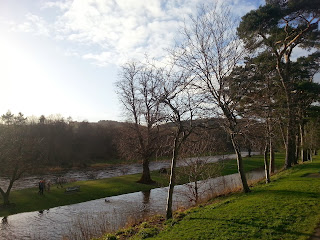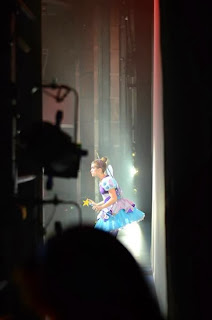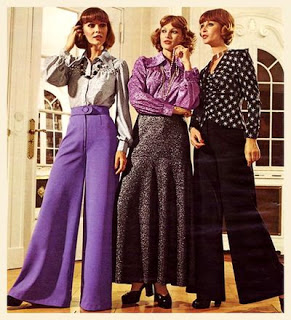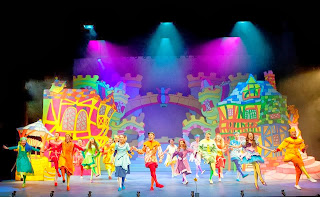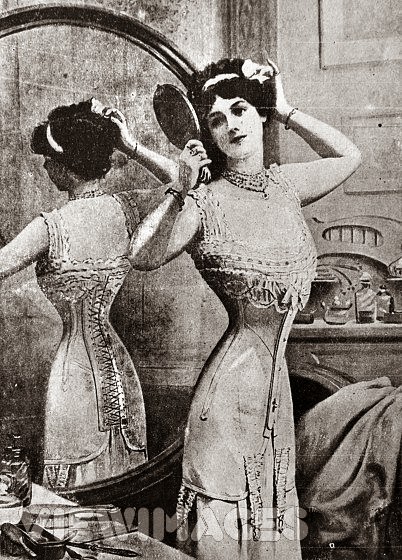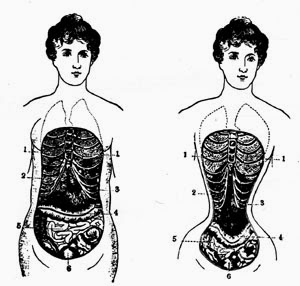Wednesday 25 December 2013
Sunday 15 December 2013
Panto After Thought
I've reached the end of my first full show; taking the costume from the design and being evolved till the last curtain fell. It's definitely been an amazing experience. I've learned to much from this and it's made me realise this is what I want to do with my life. It's stressful and annoying at times but its worth persevering when you see your hard work on the stage and hearing how much people have enjoyed it. I'm happy to be moving onto another show but sad that we don't work with that cast again. They were amazing fun and so helpful; we were very luck to have that for our team. :) I won't miss the sweaty tights and tops though.
So Panto 2013 over and out :D
So Panto 2013 over and out :D
Friday 13 December 2013
Panto Shows Week!!!
Sunday 8 December 2013
1950-2000
Part 2
1950s:- Gathered Skirts and Night Halls
Fashion details:- http://shopruche.com/1950s-fashion.html
1960s:- Hippies and Boho
Fashion details:- http://shopruche.com/1960s-fashion.html
1970s:- Disco fever and Punk Rocker
Fashion details:- http://pongogirl2.hubpages.com/hub/1970s-Fashion
http://www.glamourmagazine.co.uk/fashion/celebrity-fashion/2011/03/70s-fashion-style-icons
1980s:- The Good the Bad and The Ugly
Fashion details:- http://www.liketotally80s.com/top-80s-fashion-trends.html

1990s:-“The decade fashion has forgotten.”
Fashion details:-http://sammydvintage.com/vintage-style/90s/1990s-fashion-trends/
Fashion Moments:- http://www.marieclaire.com/fashion/trends/best-fashion-moments-of-the-90s#slide-1
So true its scary:- http://www.huffingtonpost.com/2013/04/09/90s-fashion-trends_n_3040200.html
2000:-The Naughties
Fashion details:- http://www.theage.com.au/lifestyle/fashion/long-and-short-of-the-way-we-wore-20091229-lisk.html
Key trends:- http://www.buzzfeed.com/leonoraepstein/forgotten-early-2000s-trends
Tv and Movies:- Vera Drake 2004, Famous Five (books), The Notebook 2004, Grease 1978, Almost Famous 2000
1950s:- Gathered Skirts and Night Halls
Fashion details:- http://shopruche.com/1950s-fashion.html
1960s:- Hippies and Boho
Fashion details:- http://shopruche.com/1960s-fashion.html
1970s:- Disco fever and Punk Rocker
Fashion details:- http://pongogirl2.hubpages.com/hub/1970s-Fashion
1980s:- The Good the Bad and The Ugly
Fashion details:- http://www.liketotally80s.com/top-80s-fashion-trends.html

1990s:-“The decade fashion has forgotten.”
Fashion details:-http://sammydvintage.com/vintage-style/90s/1990s-fashion-trends/
Fashion Moments:- http://www.marieclaire.com/fashion/trends/best-fashion-moments-of-the-90s#slide-1
So true its scary:- http://www.huffingtonpost.com/2013/04/09/90s-fashion-trends_n_3040200.html
2000:-The Naughties
Fashion details:- http://www.theage.com.au/lifestyle/fashion/long-and-short-of-the-way-we-wore-20091229-lisk.html
Key trends:- http://www.buzzfeed.com/leonoraepstein/forgotten-early-2000s-trends
1920-1940
This is were fashion started to really change and became a quick fire of new trend after new trend. This is were most fashion students look for ideas of fashions to bring back and most of today's fashions come from. There are thousands of books on this subject so I'll put links to the best places for key info. Perfect video to show this:- http://www.youtube.com/watch?v=3RazhSe84LU&feature=share&list=PLsSSX4qXgOuYHn54DlSfTYn6cFxjv_VkH&index=1
1920s:- Flatter girls. No more corsets.
Fashion details:- http://shopruche.com/1920s-fashion.html
1930s:- Start of the war
Fashion details:- http://shopruche.com/1930s-fashion.html
Key trends:- http://sammydvintage.com/vintage-style/30s/1930s-fashion-clothing/
1940s:- Pin up girls
Fashion details:- http://shopruche.com/1940s-fashion.html
TV and Movies:- Downton Abbey 2010-, Atonment 2007, Mrs Pettigrew Lives for a Day 2008, Great Gatsby 2013, The Mummy 1999-2001, The Narnia series 2005-2010, The Edge of Love 2008, Cold Comfort Farm 1995, Bright Young Things 2003.
References:-
The Little Guide to Vintage Shopping by Melody Fortier
http://vintagefashionguild.org/fashion-timeline/
History:- World War I and II, Woman got the vote.
1920s:- Flatter girls. No more corsets.
Fashion details:- http://shopruche.com/1920s-fashion.html
1930s:- Start of the war
Fashion details:- http://shopruche.com/1930s-fashion.html
Key trends:- http://sammydvintage.com/vintage-style/30s/1930s-fashion-clothing/
1940s:- Pin up girls
Fashion details:- http://shopruche.com/1940s-fashion.html
References:-
The Little Guide to Vintage Shopping by Melody Fortier
http://vintagefashionguild.org/fashion-timeline/
History:- World War I and II, Woman got the vote.
Panto Tech Week
03/12/2013
Its not as bad as I thought it would be. Lots of standing about and lots of note taking and chasing up actors. There all lovely but some need to take better care of costumes. I forget my stresses wile doing maintenance and washing which is a nice distraction before the shows. I've started to like those jobs when my brain can't take things. But its really come together now and there all a great bunch to work with. :) It's made me realise this is what I want to do with my life. Such an amazing buzz.
Tech week
First preview
Its not as bad as I thought it would be. Lots of standing about and lots of note taking and chasing up actors. There all lovely but some need to take better care of costumes. I forget my stresses wile doing maintenance and washing which is a nice distraction before the shows. I've started to like those jobs when my brain can't take things. But its really come together now and there all a great bunch to work with. :) It's made me realise this is what I want to do with my life. Such an amazing buzz.
Tech week
First preview
Saturday 7 December 2013
Edwardian 20th Century
 This time period was very short only 10 years so the fashions from the Victorian period were still present but
This time period was very short only 10 years so the fashions from the Victorian period were still present butbig changes were still a foot. This was the start of when fashions started to change every ten years.
Fabrics which were common during this time were voile, silk, linen and cotton. Bold pattern fabrics like strips became very popular which started to show as pin stripped fabric. Knife pleats, braided trimmings, stitching trim and pin tucks were all widely used for designs.
Women's fashion became more masculine because of suit cut style jackets with wide collars, reveres and lapel jackets. Double darts were often used to add more shape to the front of jackets and often sat wide off the shoulders sometimes the sleeves were cut out in the same piece as the rest of the bodice. Jackets were often cut away or very straight lined. No gathers. Loose blouses with nipped in waists were all the rage; they often had stiff high neck collars. This look kind of reminds me of a pigeon because of the corset pulling the hips back and sticking the gathered chest out. Waists were belted or pulled in with fabric in a bow to show off the tiny waist line. Sleeves started to become three quarter length mostly on blouses and often tight or to the other extreme were they were "leg-of-mutton sleeves". Sleeves on jackets and blouses often had deep cuffs which were buttoned with small pearl white buttons. The difference between day wear and night wear became very obverse. Neck-lines were low and square and often skirts had layers and were gathered with lots of details similar to the Victorian era.
Flare skirts with full backs were the most common cut of skirt which was made fuller with a small petticoat with a small bum roll and back ruffles. Hem lines started to rise to around the ankle. After a wile narrow hight waisted skirts with flared hems became worn thus getting rid of the bum rolls which never came back into fashion.
There was lots of accessories which were made popular around this time. Spotted veils worn with small hats or fixed to the hair became very fashionable for day wear. Hats with beard trim, massive over sized brim hats with decoration, large brim hats with ostrich feather trims were all the rage. Clothes were kept minimum wile there hats went big and wide brimmed. Bolero became very popular which were small shrugs to pull over the shoulder. Other fabric details included large decorative buttons, bows and decorative seams. Parasols, brooches and tiered lace ruffle neck scarf were often seen during this time.

Movies and TVs:- Finding Neverland 2004, Titanic 1997, The Importance of Being Earnest (play), Dorian Gray 2009, Dracula 2013, A Little Princess 1995, The House of Mirth 2000, My Fair Lady (book), The Winslow Boy 1999, Howards End 1999, The Forsyte Saga: To Let 2003,Berkeley Square 1998, The Englishman Who Went Up a Hill But Came Down a Mountain 1995, The Railway Children 2000, Mrs Dalloway 1997
References:-
http://enchantedserenityperiodfilms.blogspot.co.uk/2011/01/edwardian-fashion-image-gallery.html
http://thats-not-victorian.tumblr.com/post/34824134342/womens-fashion-timeline-19th-and-early-20th
http://vintagefashionguild.org/fashion-timeline/
http://www.tudorlinks.com/treasury/articles/view1900.html
Beautiful reference pictures:- https://www.pinterest.com/americanduchess/edwardian-fashions-1900-19teens/
Pictures of the time:- http://www.retronaut.com/2012/06/street-fashion-in-london-and-paris-1905-1908/
History:- Chaplin, The Titanic Sunk
Monday 2 December 2013
Edwardian Corset
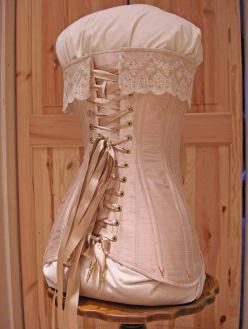
The straight-front corset, also known as the swan-bill corset, the S-bend corset or the health corset, was worn from circa 1900 to the early 1910s. Its name is derived from the very rigid, straight busk inserted in the centre front of the corset. This corset forced the torso forward and made the hips jut out in back. The straight-front corset was popularised by Inez Gaches-Sarraute, a corsetiere with a degree in medicine. It was intended to be less injurious to wearers' health than other corsets in that it exerted less pressure on the stomach area. However, any benefits to the stomach were more than counterbalanced by injury caused to the back due to the unnatural posture that it forced upon its wearer. At this time, the bust lowered and corsets provided much less support for the breasts.
From 1908 to 1914, the fashionable narrow-hipped and narrow-skirted silhouette necessitated the lengthening of the corset at its lower edge. A new type of corset covered the thighs and changed the position of the hip, making the waist appear higher and wider. The new fashion was considered uncomfortable, cumbersome, and furthermore required the use of strips of elastic fabric. The development of rubberised elastic materials in 1911 helped the girdle replace the corset.
Victorian 19th Century

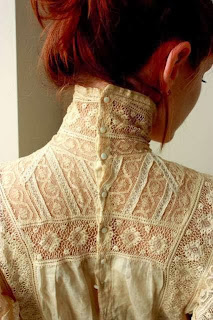 Victorian fashion is one of the most complicated to write about as it went over a great many years and in that time the silhouettes changed at least 3 to 4 times to see a wonderful breakdown see:- http://trulyvictorian.com/history.html. The clothing is all based around the S line or hourglass shape which was created by the corsets. This time period has some of my favourite style details.
Victorian fashion is one of the most complicated to write about as it went over a great many years and in that time the silhouettes changed at least 3 to 4 times to see a wonderful breakdown see:- http://trulyvictorian.com/history.html. The clothing is all based around the S line or hourglass shape which was created by the corsets. This time period has some of my favourite style details.Beginning:-
During this time fabrics were starting to become much more available because of cotton production and larger imports. Spotted muslin, taffeta and silk were commonly used for evening or fancy occasions. Woven fabric fabrics were widely available. Lace, ribbons and fringing were widely used as decoration.
Draped silk, braid trim, rushing, bias binding were used to embellish bodices and skirts with lots of fabric edges decorated.
Bodice waist lines had fallen again; to help to start to give this S-line silhouette. Off the shoulder bodices were very common for evening wear to help to show off the collar bone which was seen as being very attractive. Velvet inset panels were commonly used around the neck to cover the bust often added to old dresses with a square neckline. Over sized collars,frilled over sleeves, tight cuffs,short puff sleeves, peplums, shaped cuff sleeves,large sleeve decorations, circular cuffs were all very popular during this time period.
For the skirts they went giant again with the aid of hoop skirts/ crinoline cages, large bum rolls and petticoats. This helped to relieve some of the weight from the lower back. Tiered skirt and double frills at the hem were exceedingly popular for all times of day.
Common accessories of the time included ring letting the hair with bows and ribbons to hold them in place, artificial flowers, small bonnets, fitted coats to help to show off the tiny waist, decorative braid/ frog fastenings, shawls, large brooches, drape earrings, small bowler hats and capes.
Middle:-
Striped and patterned fabrics were heavily used during this time. Man made dies were starting to be used thanks to industry so navy and indigo coloured fabrics were very common place. Bias cut fabrics started to be used because it was found they draped better than weft cut fabric.
Bodices sleeves started to puff out again, waist position rose a bit so that bodices would sit on the natural waist and not on the hip. Large cuffs and small stand collar were widely used.
Skirts had paded and frilled petticoats, top skirts pulled back by swags for more volume and to create a train. This created a very flat front and sides skirt with everything pulled to the back. Under skirts were embroidered as they were seem, extra fabric was added to the back for more draping. Apron fronts with decorated edges often covered the front of dresses and hems often had large pleated attached.
Hair net with beads attached started to be worn to hold the hair back. Short gloves and straw hats with ribbons and flowers were worn every day when travelling.
Brocade fabric came back into fashion and pipping decorations started to be seen very often.
Bodice shoulder points were set further back to encourage you to sit with a proper posture. Bodices extended again so that they sat over the hips with an extra back panel used to make the jackets a closer fit. Seams were boned to help retain the structure and to aid corsets with holding the wearer in. Neck lines were high during the day and often tucked or pleated were as for evenings they neck-lines were off the shoulder or scoop necked.
Skirts unlike the bottoms were very full with long trains, narrow hems,gathered bustles. Lots of ruffles, lace, gathers and rushing to create volume. This all helped to show off the tiny waists.
Felt hat with feathers in a small bowler hat fashion were often worn on day outings. Another hat that was very popular was a narrow curved brims hat which was often decorated with silk flowers. Women started to carry small fabric bags. Pearl necklace, earrings and fancy broochs were often worn mostly commonly about the throat to hold up a scarf or tucked neck line. Narrow cut leather boots with toe caps were all the range.
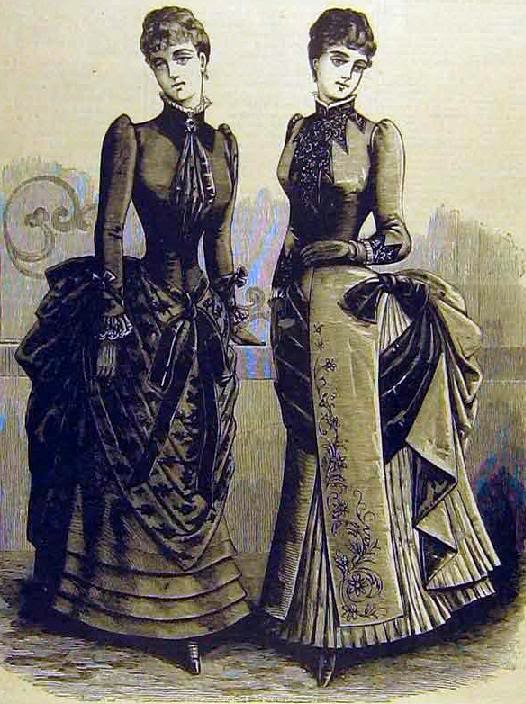

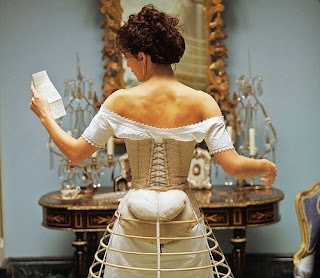
Movies and TV:- The Young Victoria 2009, Dracula 1992, As You Like It 2006, The Age of Innocence 1993, Cold Mountain 2003, Far and Away 1992, The Illusionist 2006, The Prestige 2006, The Legend of Zoro 2005, The Portrait of a Lady 1996, Sweeney Todd 2007, The Phantom of the Opera 2004, Moulin Rouge 2001, Interview with the Vampire 1994, Stardust 2007, Anna Karenina 2012, Jane Eyre 2011, Tipping the Velvet (book), Victoria and Albert 2001, The Beaux' Stratagem (play), North and South 2004, Kate and Leopld 2001, Great Expectations 2012, Secret Garden 1993, Dorian Gray 2009, Sherlock Holmes 2009-2011, League of Extraordinary Gentlemen 2003, Ripper Street 2012-2013, The Raven 2012, Cranford 2007, Lark Rise Candleford 2008, The Invisible Woman Trailer 2013, The Lone Ranger 2013
History Events:- Napoleonic wars. The First Railway. First Education Act, Industrial revolution, Victoria became the longest raining monarch.
References:-
Patterns of Fashion 2 by Janet Arnold
http://thats-not-victorian.tumblr.com/post/34824134342/womens-fashion-timeline-19th-and-early-20thGreat reference for outfit break down and how the fashions changed:- http://victorianeracnr.blogspot.co.uk/2011/01/fashion.html
Amazing pictures and references:- http://www.vam.ac.uk/page/v/victorian-fashion/
For fun:- http://www.youtube.com/watch?v=MR6q5m258Mk
http://www.youtube.com/watch?v=z6IPjwR1j5w
Saturday 30 November 2013
Victorian Corsets


A big change from the more comfortable Regency corsets. I think today these are the types of corsets most people think of first when the topic is thought up. they had such a massive impact on woman's bodies. They were all about making the waist like an hour glass or S shape. Pulling the waist in and will pulling the bust in. Corsets stopped being worn at the hip and extended to several inches below the hip. They were made with whale bone or iron metal pieces, thus restricting movements. The were strung a set way with the knot in the middle so as to take in as much pressure as possible when tightening. See video:- http://www.youtube.com/watch?v=lKFuGAIUrBY

This caused massive health implications without even realising it. Doctors used to actually proscribe them to women for helping posture and getting rid of pregnancy fat. Corsets were even worn during pregnancy. The biggest problem was the miss placement of the organs which cold cause haemorrhaging, blood clots, weakness of muscles and organ damage or failer in worse cases.
Final Week of Panto Costume Construction

Date: 26-29/11/2013



Not going to lie this week has been so hard. But it was all worth it. I completed the costume...
Tasks completed:
- Attaching the skirt to the bodice
- Made two pairs of tights
- Put in boning and bound the end of the bodice
- Made the wings
- Added on the fastenings
- Add managed to glitter her up :)
I'm very happy with the result and can't wait to see my fairy in full costume.
Learned: That its worth all the pain and frustration when the costumes finished.
Subscribe to:
Posts (Atom)
